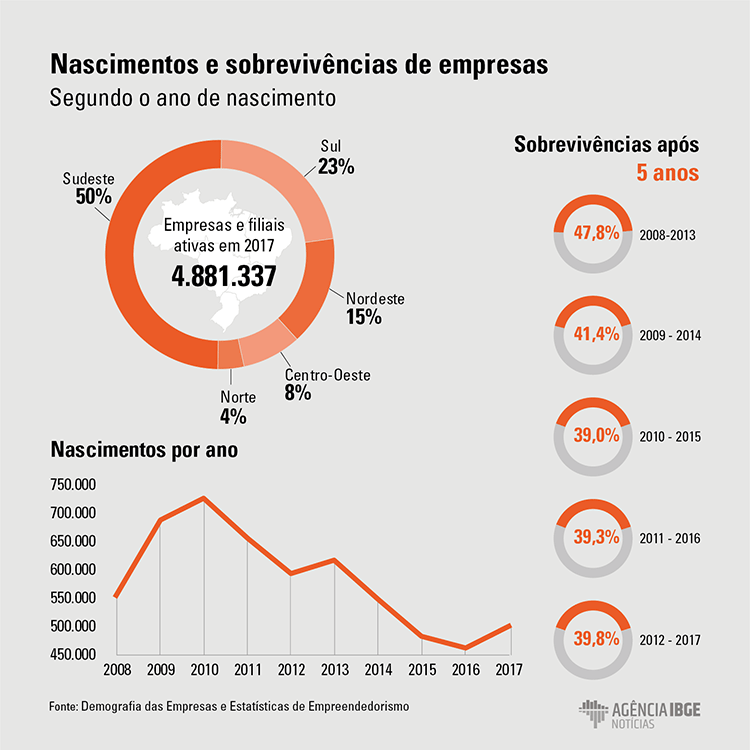Six out of every ten enterprises born in 2012 closed their doors in a five-year time
October 17, 2019 10h00 AM | Last Updated: October 17, 2019 04h37 PM

Among the enterprises born in 2012, nearly 40% of 597.2 thousand were still active in 2017. This proportion, measured by the survival rate, shows that six out of every ten enterprises closed their doors in five years. The data are from the survey Demography of Enterprises and Statistics of Entrepreneurship, released today by the IBGE.
In 2017, the survey recorded that there were around 4.5 million enterprises in the country, 22.9 thousand less enterprises in comparison to the previous year. Electricity and gas were the activities with higher proportion of new enterprises in the year (23.3%), meanwhile the construction sector recorded the higher proportion of enterprises that closed their doors (20.8%).
The survey analyst, Denise Guichard, explained that the balance of enterprises in the market had been under a positive trend until 2013. “It had had almost 4.8 million enterprises in activity in the country, with a positive balance of 175 thousand in relation to 2012, the number of enterprises was rising. But that number has been decreasing with negative balances since 2014, when there was the worst slump, almost 218 thousand enterprises closed”.
The survival rate tends to reduce throughout the years. For example, of the organizations created in 2012, 78.9% survived after one operating year, 64.5% after two years, 55% after three years, 47.2% after four years and 39.8% were still in active business in 2017. Of the 558.6 thousand enterprises created in 2008, 47.8% survived within five years.

Considering only the survival rate in the first year, the highest rate was recorded in 2008 (81.5%), decreasing in the next years, achieving the 71.9% in 2013, but it rose in 2014 (77.2%) and 2015 (78.3%), rebounding again to 73.2% in 2016.
Among the surviving enterprises in 2017, almost 60% had at least one salaried person. “The majority of closed enterprises consisted only of the owner and partners”, explains Denise.
She also highlights that among the surviving enterprises, 14.3% of salaried persons have a higher education degree. “In the new enterprises, the employees with a higher education degree compose only 8.7%. In the closing enterprises, they are 7.6% of the salaried persons”, claims the survey analyst.
In the entrepreneurship analysis, the survey study, besides other aspects, high-growth enterprises, which are the ones that had 10 or more salaried employed persons in the first year of observation and that record an annual average growth of salaried employees of at least 20% in a period of three years.
The survey shows that the 20,306 high-growth enterprises represents the smallest number in the series started in 2008 (30, 954), while the highest number was recorded in 2012 (35,206). Between 2016 and 2017, there was a reduction in the number of high-growth enterprises, both in absolute terms, 692 enterprises, and in relative terms, 3.3%.
The group represented 0.5% of active businesses, 0.8% of enterprises with salaried employees and 4.5% of the enterprises with 10 or more salaried employees.




















